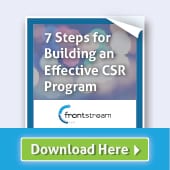 For many of us, the start of a new year means getting back to the gym followed by insistent intent to use that juicer more often (2015 will be the year, I swear).
For many of us, the start of a new year means getting back to the gym followed by insistent intent to use that juicer more often (2015 will be the year, I swear).
But for corporate social responsibility (CSR) departments, the new year is an opportunity to look back on what worked, what didn’t, and find the trends that will define your next workplace philanthropy program.
In our studies examining hundreds of CSR programs, we found four common trends that will make 2015 the year of impactful corporate philanthropy. Here’s what you need to know:
Create Shared Value (CSV)
As an expansion of traditional CSR, shared value reshapes the relationship between corporations and charitable organizations.
CSV shifts our focus away from treating businesses as large-scale donors and views them as agents of change themselves, capable of resolving society's most pressing issues. Where CSR is an after-thought to business operations, CSV changes those core processes in a way that addresses social or environmental needs.
A great example of a company creating quality products that create shared value is Nestle. It's no mistake why Nestle has been able to invest in youth programs, food distribution networks, and community service. It’s embedded in their mission statement:
“For a company to be successful over the long term and create value for shareholders, it must also create value for society. At Nestle, this begins with the creation of superior long-term value for shareholders by offering products and services that help people improve their nutrition, health, and wellness.”
Recognizing that their position in society brings both opportunities and responsibilities, Nestle creates long-term value by:
| Corporate Commitment | Social Benefit |
|
|
|
|
|
|
|
|
|
|
For the full list of commitments, progress, and objectives, check out Nestle’s CSV website.
CSV does not change the business objective to make money. Instead, it changes the “how.” By creating products and services in a way that address sustainability and society, corporations are better positioned to create long-term impact.
Use Skills-Based Volunteerism to create shared value
According to the Taproot Foundation, charitable organizations have access to only 3% of the services they need, such as accounting, marketing, and legal services. One way corporations can help charitable organizations fill these needs is through skills-based volunteering.
Think about it. Your company hires talented people each year to help your business develop and grow. Giving your employees the opportunity to bring their much-needed skills to a charitable organization will not only help a worthy cause, it will improve worker morale and productivity.
Recent studies have shown that corporate volunteer programs can develop workplace skills like leadership and management, at one-third the cost of traditional development programs. This means corporations can enhance employees’ skills at a lower cost while meeting a social need, thus creating shared value.
More businesses are realizing the economic benefits of skills-based volunteerism. In the CECP’s 2014 Giving in Numbers report, we see that about 50% of companies have a pro bono program in place. Growing from 30% in 6 short years, this is the fastest growing trend in employee engagement.
Peer-to-Peer Fundraising has arrived for businesses. Leverage it.
Peer-to-peer (social) fundraising is nothing new to nonprofits and individual fundraisers. In fact, many nonprofits have successfully integrated it into their overall fundraising strategy to raise hundreds of thousands of dollars. Through social fundraising, nonprofits tap into two potent resources they wouldn’t ordinarily have: added motivation and a larger social network.
Think about it like this: are you more likely to give directly to a charity or in support of a loved one participating in a cause-related event? The added motivation that a fundraiser gives to donors expands the nonprofit’s network beyond what they could reach on their own. Considering the average fundraiser raises about $500 from their peers, it seems that most people would rather give through a loved one.
Social fundraising is making its foray into the corporate scene as a way to increase community involvement and impact.
In corporate campaigns, social fundraising can make an exponential increase on your company’s impact since its support base grows to include employees’ families and friends.
Have you thought of holding a company-wide event, like an Earth Day Walk or sponsoring a marathon team? Have you considered employee-driven CSR? With peer-to-peer fundraising tools, employees can create team, event, and personal pages in support of causes. They can share these sites with their social networks to fundraise for your events and for the causes they truly care about.
Check out this example: http://www.firstgiving.com/ExampleLandingPage
Look Beyond Borders: The Rise of International Giving
In the 2013 Global Impact study, 60% of companies reported foreign charitable donations. The trend to expand employee engagement programs from the home country to overseas locations isn’t new. According to a 2014 study by LBG Associates, this trend stems from a global recognition of CSR value, as well as globalizing businesses.
With more employees outside the home country, executives are looking to unify satellite offices and act more like a global company. Companies are looking to offer equal opportunities to employees around the world, including volunteer and employee-directed giving programs.
As this trend becomes more commonplace at international corporations, there will be a need to have “eyes and ears” on the ground. Most companies won’t have the luxury of having a dedicated, paid staff to manage global employee engagement programs. As a solution, they rely on employee volunteers to act as overseas citizenship staff to localize CSR programs to resolve regional needs.
Interest in international giving shows no sign of slowing down. More than four-fifths of companies that give internationally say they’ll increase or maintain their foreign giving budget size.
Whether your company has international reach or makes use of peer-to-peer fundraising, better aligned business strategies and nonprofit partnerships will increase impact for many corporations in 2015.
Here’s to increased impact and continued expansion in the new year!
 Getting an effective CSR program off the ground isn't easy. All too often, a program is received with enthusiasm at the beginning and then gets pushed off to the side for other priorities. This doesn't have to be the case.
Getting an effective CSR program off the ground isn't easy. All too often, a program is received with enthusiasm at the beginning and then gets pushed off to the side for other priorities. This doesn't have to be the case.
Download the 7 Steps for Building an Effective CSR Program eBook for best practices that will help you develop a program that is truly valued by your organization.